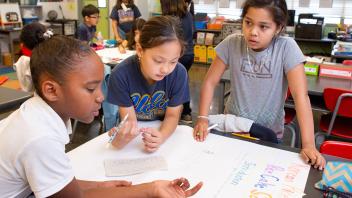Less is known about the components of effective mathematics instruction than about the components of effective reading instruction, because research in math is less extensive than in reading. However, conclusions still can be drawn from some very good studies that do exist, as well as from typical grade level expectations in math. As is true for reading, there is no single “best” program for teaching mathematics. Rather, certain key abilities involved in learning math need to be addressed in instruction, with the importance of different abilities shifting somewhat across the elementary and secondary grades.
Effective kindergarten through grade four instruction
At these grade levels, general education instruction in mathematics should include development of the following math-related abilities: concepts and reasoning (e.g., basic number concepts, meaning of operations such as addition, geometric concepts); automatic recall of number facts (e.g., memorization of basic addition facts such as 3 + 4 so that children know answers instantly instead of having to count); computational algorithms (the written procedure or series of steps for solving more complex types of calculation, e.g., for two-digit addition with regrouping, calculation starts in the right-hand column and tens are “carried” from the ones to the tens column); functional math (e.g., practical applications such as time and money); and verbal problem-solving (e.g., solving word problems).
Because progress in math builds heavily upon previously learned skills, it is important for instruction to be clear, unambiguous, and systematic, with key prerequisite skills taught in advance. For instance, children should not be expected to develop automatic recall of addition facts if they do not understand the basic concept of addition or the meaning of the addition sign. It is also essential for children to have sufficient practice to acquire new skills. For example, although manipulatives such as cubes or rods can be very helpful in developing basic concepts, many children will not spontaneously progress from accurately solving facts with manipulatives to automatic recall of facts. Instead, most children benefit from practice activities focused specifically on helping them to memorize facts. Similarly, learning computational algorithms such as those used in long division or two-digit multiplication often requires considerable practice.
Scientific investigators interested in learning disabilities have identified several patterns that may be found in youngsters with math disabilities. Some of these children have difficulties that revolve primarily around automatic recall of facts, coupled with good conceptual abilities in mathematics; this pattern characterizes some children with reading disabilities. Another common pattern involves difficulties with computational algorithms; yet a third pattern involves visual-spatial difficulties, such as difficulty lining up columns or with learning spatial aspects of math, such as geometry. Although effective general education instruction can help to prevent low math achievement in many children, some youngsters with genuine math disabilities will require more intensive, long-term instruction in order to be successful.
Grade five and beyond
In grade five and beyond, general education instruction in math focuses a great deal on advanced concepts and reasoning (e.g., what a variable or a function is), learning of complex computational algorithms (e.g., those involved in adding and subtracting fractions and decimals), and more difficult kinds of verbal problem-solving (e.g., problems with multiple steps). By grade five, automatic recall of number facts is well-developed in most normally-achieving youngsters. However, youngsters with math disabilities often continue to struggle with math skills far below grade expectations, including not only automatic recall, but also many computational algorithms and math concepts. A thorough evaluation that assesses a range of important math skills is essential, because children can have different strengths and weaknesses even within the domain of math, and knowing the pattern of strengths and weaknesses is central to instructional planning. For instance, a child who has good conceptual abilities but whose difficulties center on automatic recall and computation will need a different kind of instructional program than will one whose main difficulties are conceptual in nature.
As children advance into middle and high school, tracking of students into different levels of math (e.g., an accelerated track, a grade-level track, and a remedial track) is typical. Also, science courses begin to draw more heavily on mathematics skills, and students with math disabilities may begin to experience more difficulties in science. Providing intensive remediation of basic math skills to students who need it remains essential in these grades, not only to help students acquire the skills needed for everyday life, but also because math achievement serves as a gateway for higher education and for many occupations.
Examples of sources
Peer-reviewed journal articles:
Carnine, D. (1997). Instructional design in mathematics for students with learning disabilities. Journal of Learning Disabilities, 30, 130-141.
Cawley, J., Parmar, R., Foley, T., Salmon, S., & Roy, S. (2001). Arithmetic performance of students: Implications for standards and programming. Exceptional Children, 67, 311-330.
Fuchs, L., & Fuchs, D. (2001). Principles for the prevention and intervention of mathematics difficulties. Learning Disabilities Research & Practice, 16, 85-95.
Maccini, P., & Gagnon, J. (2002). Perceptions and application of NCTM Standards by special and general education teachers. Exceptional Children, 68, 325-344.
Other helpful sources:
Curriculum and evaluation standards for school mathematics. (2000). Reston, VA: National Council for Teachers of Mathematics.
Fuchs, L., & Fuchs, D. (2003). Enhancing the mathematical problem solving of students with mathematics disabilities. In H. L. Swanson, K. R. Harris, & S. Graham (Eds.), Handbook of Learning Disabilities (pp. 306-322). New York: Guilford.
Geary, D. C. (1996). Children’s mathematical development. Washington, DC: American Psychological Association.
Rivera, D. P. (1998). Mathematics education for students with learning disabilities: Theory to practice. Austin, TX: Pro-Ed.
Stein, M., Silbert, J., & Carnine, D. (1997). Designing effective mathematicsinstruction: A direct instruction approach (3rd edition). Upper Saddle River, NJ: Merrill.
Stevenson, H.W. & Stigler, J.W. (1992). The learning gap. New York, NY: Summit Books.
